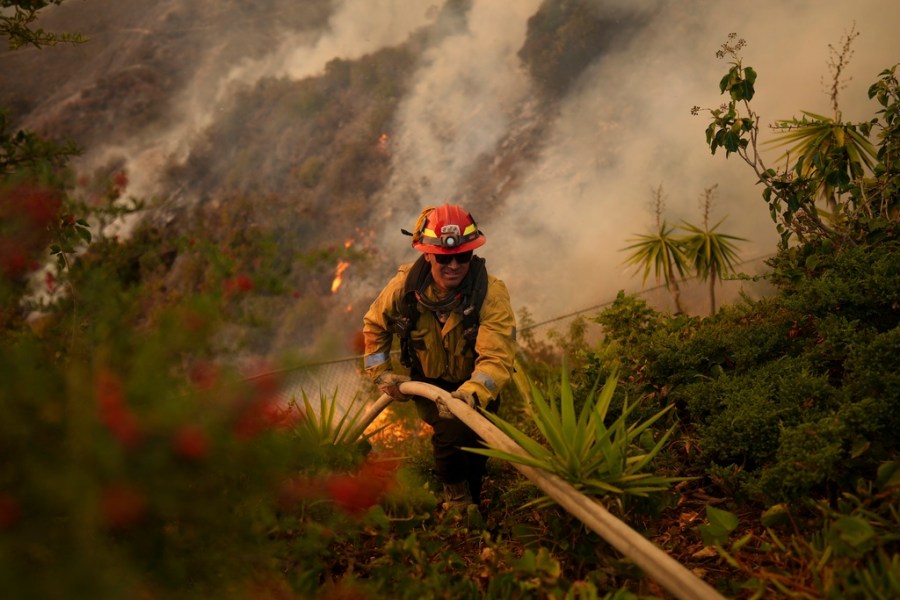
After spending weeks battling devastating wildfires in Southern California, support programs are working to address fatigue and mental health issues facing many firefighters and first responders. .
In addition to traditional talk therapy, local fire departments and police departments are working to reduce the stigma surrounding mental health care for first responders through alternative methods with positive outcomes.
“These firefighters went from house to house without a break for 48 hours, stopping at the fire station,” said Santa Monica Fire Department Chief Matthew Hallock. “The magnitude of this incident – it was a carrier fire in 48 to 72 hours.”
Hallock was one of the thousands of firefighters who fought the Palisade fire. As many people return home from deployment, they may be dealing with feelings of helplessness, fatigue, and mental health struggles.
“First responders face unique mental health challenges,” explained police and public safety scientist Dr. Gina Gallivan. “They are exposed to trauma, threats to their lives, and have long changes without much physical recovery.”
Firefighters set up hoses while battling the Palisade Fire in Mandeville Canyon on Saturday, January 11, 2025 in Los Angeles. (AP Photo/Eric Thayer) Watch as water is dropped on the Mandeville Canyon Fire in Los Angeles, Saturday, Jan. 11, 2025, in Mandeville Canyon. (AP Photo/Jae C. Hong) A firefighter jumps over a fence while battling the Palisades Fire in the Pacific Palisades neighborhood of Los Angeles, Tuesday, Jan. 7, 2025. Matt Phillips, left, from the Kitsap County Firefighters Strike Team on Bainbridge Island, Washington, leads a crew while checking a home for structural issues in the aftermath of the Palisade Fire in the Pacific Palisade neighborhood of Los Angeles on Friday. Jan. 17, 2025 (AP Photo/Richard Vogel) A residence is on fire as firefighters battle the Palisade Fire in the Pacific Palisades neighborhood on Tuesday, Jan. 7, 2025. Captain Manuel Lafarga, center, and firefighter James Lyons hose down a hot spot in the aftermath of the Palisades Fire in the Pacific Palisades neighborhood of Los Angeles, Monday, Jan. 13, 2025. 8: Firefighters battle the Palisade fire while burning a house on the Pacific Coast Highway during powerful wind storms on January 8, 2025 in Los Angeles, California. A fast-moving wildfire has grown to more than 2,900 acres and is threatening homes in coastal areas amid Southern California’s fierce Santa Ana winds and dry conditions. (Photo by Apu Gomes/Getty Images) Firefighters protect structures as the Eaton Fire advances in Altadena, California, on Wednesday, January 8, 2025. (AP Photo/Ethan Swope) Firefighters damage property. Therefore, try to extinguish the fire. Tuesday, Jan. 7, 2025, Pacific Palisades neighborhood in Los Angeles AP Photo/Etienne Laurent) Firefighters battle the Palisades Fire around a burned structure in the Pacific Palisades neighborhood in Los Angeles, Wednesday, Jan. 8, 2025. The Franklin Fire approaches Pepperdine University faculty and staff housing on Tuesday, December 10, 2024 in Malibu, California. January 7, 2025 in Palisade, California. (Getty Images)
For the past 20 years, Gallivan and her team have served over 100 police departments and public service agencies in Southern California, providing peer support programs and tailored counseling to first responders.
Gallivan said the main goal is to make sure these local heroes know that asking for help is not a sign of weakness.
“There is a stigma associated with asking for help,” Hallock said. “We feel like this profession gives us a kind of invulnerability. But in reality, we’ve seen cases where firefighters are taking their own lives.”
Gallivan incorporates evidence-based wellness components and counseling such as biofeedback, contrast therapy, and multisensory feedback at his Reality Center in Santa Monica.
“We found that when we provide both of these together, those symptoms resolve faster,” Gallivan explained.
By combining light, sound, and vibration into a unique experience, Reality Center provides healing in a safe and effective way without pharmaceuticals.
Approximately 75% of those treated at real-world centers are veterans and first responders. The center provides free treatment to all firefighters, police, and emergency personnel affected by the Southern California wildfires.
“When you step out of line, they’re going to go through a lot of the same things we go through when we come back from war,” said Jonathan Chia, co-founder of the Reality Center. said. “So balancing the nervous system and allowing people to relax, calm their bodies and get a little bit of sleep so they can feel reset the next morning is most important to us.”
“We put them in here to reset them and make them feel balanced in their nervous system before they come back or it starts to escalate into something much more problematic,” said the Reality Center. co-founder Tarun Raj explained.
Gallivan said first responders should know they don’t have to shoulder the burden.
Hallock says he is considering providing comfort dogs to the Santa Monica Fire Department, saying public support for first responders is an important part of their healing.
“It doesn’t have to be money or items. It’s just stopping by and saying ‘hello’ or ‘thank you’ or acknowledging what firefighters are doing and continuing to do,” Hallock said. Ta.
For more information about mental health services, please visit helpforfire.com. Click here for information about Santa Monica’s Reality Center.
Free IV therapy for first responders is provided in the hydration room to restore hyper-wellness.
Source link




